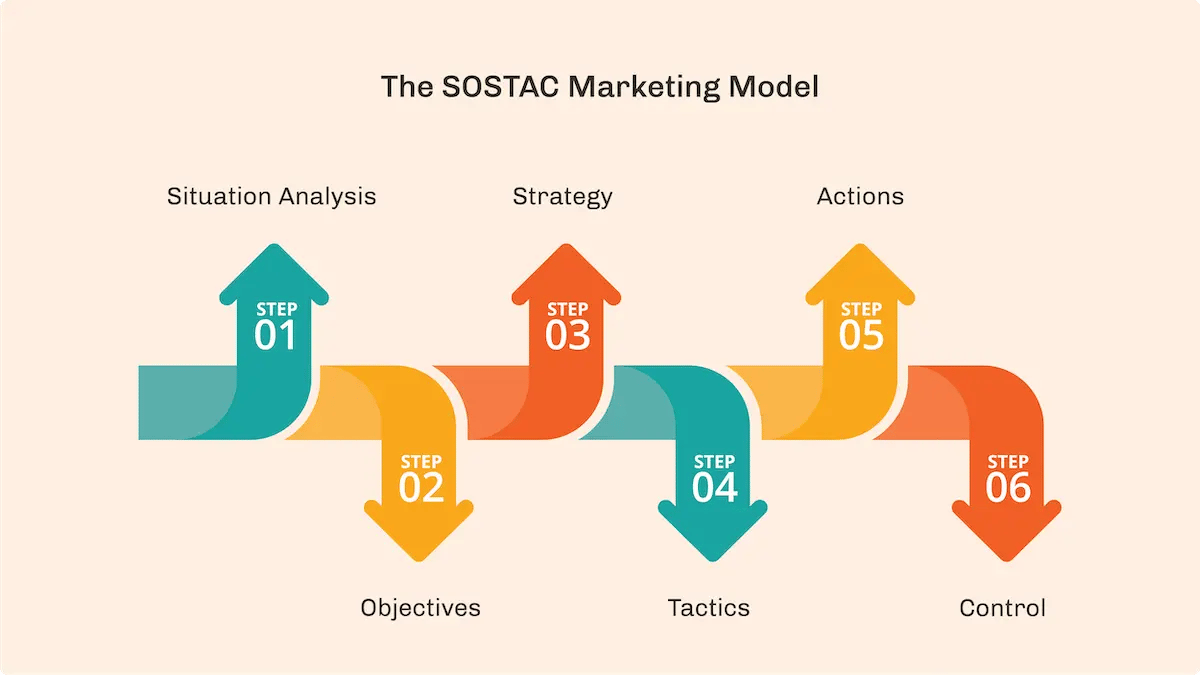SOSTAC - The Marketing Planning Model
SOSTAC is a marketing planning model designed to help today’s companies make time for different planning activities. Used both for overall marketing initiatives and digital marketing strategies, SOSTAC has become one of the most relied-upon and easy-to-use marketing strategies today.
If you are looking for a new marketing planning model that can keep you more organized, then take a look at the SOSTAC model. Never heard of it before? Not a problem, we’re here to help you learn the ins and outs of this approach.
Ready to learn more about the SOSTAC marketing model and what it can do for you?
SOSTAC |
What is SOSTAC?
SOSTAC is a planning model first developed in the 1990s to help with marketing planning. It is an acronym for:
- Situation Analysis
- Objectives
- Strategy
- Tactics
- Actions
- Control
The model was developed by PR Smith and while it originally was meant for traditional marketing, it is easily applied to today’s modern digital marketing strategies. The acronym is designed to help create a logical approach for tackling a marketing plan but can also be used to critically assess a current marketing process.
What Are the SOSTAC Steps?
The key to SOSTAC as a general marketing strategy is the six steps involved with this model. These steps were based on Smith’s six fundamental facets of marketing, each aiming to tackle a particular challenge that most companies face.
Here’s how they all break down:
Situation Analysis
“Where are we now?”
Here businesses need to take the time to assess where they are presently in their current efforts. Ask, “where are we now?”. Look at the current status of the business and where your marketing plans lie. While looking at the current state of a company, look at the following areas:
- Consumer behavior includes how they interact with and differentiate from one another.
- The product the business is selling and the key differences between that product and the competition
- What competitors are doing and what competitive advantage the company has?
- The market environment and current market potential.
Together, this should give companies a realistic look at their current situation.
Objectives
“Where do we want to be?”
During this stage, businesses will want to set the mission or goals for their business and lay out their future plans. Ask, “where do we want to be in the future?”. This is a great time to set short-term and long-term goals.
The objectives set out in this step need to be unified and linked across all departments. These objectives should also be clearly defined and linked to the organization’s larger goals. While the decision for objectives is a leadership decision, it takes the entire team being on board to bring these to fruition.
Strategy
“How do we get there?”
During the strategy phase of marketing planning, businesses should create an overview of their plans to reach those goals and make those objectives a reality. Ask, “how do we get there?”. The strategy phase should include an overarching plan for reaching those goals and understanding what some of the particulars can shift.
This is the road map to the path you will follow to bring these objectives to life. This stage involves designing your value proposition and making certain you are positioning your product appropriately in the market.
Tactics
“How exactly do we get there?”
Here brands should look at the details involved with their strategy or the exact steps involved with reaching their goals. Ask, “how exactly do we get there?”. This is the time to look at small steps to implement, such as the marketing mix, to achieve goals.
If the strategy is the road map of where the company is going, tactics are how the company will deliver on the strategy and execute it for success.
Actions
“What is our plan?”
The next step has to do with the action steps you’re taking to ensure excellence. Ask, “what is our plan?”. These are all of those little details that will help make sure that things aren’t just done, but they’re done correctly and that the company is taking steps. This involves detailed planning and an elaborate schedule.
This stage will answer five basic questions: Who? What? Where? When? How?
Control
“What do you monitor?”
The final step involves understanding how you know whether or not you are reaching these goals. Ask, “what do you monitor?”. During this step, businesses should lay out the specifics for how they will be keeping track of their progress and ensure they are making improvements to enhance their results further.
During this stage, make sure to cover metrics such as revenue, costs, sales, margin, and customer behaviors, as these metrics will help determine the future direction of the business while keeping these goals and milestones at the forefront.
What Are the Benefits of Using SOSTAC Planning?
SOSTAC is a popular marketing tool because it provides a clear and simple structure that covers all of the stages necessary in not only creating a business marketing plan but implementing this plan as well.
Here are some of the benefits and reasons why so many companies continue to use the SOSTAC planning framework:
- SOSTAC is based on what’s happening in the company’s marketplace so it takes into account exterior factors such as influencers and competitors that can impact the company and any potential situations they may face.
- This model details clear objectives that allow businesses to achieve their vision for the future, which can be particularly important for digital marketing initiatives.
- With this framework, businesses will have a clear strategic direction, which allows the company as a whole to achieve its objectives as they form a strategy.
- SOSTAC summarizes all of the marketing techniques used in a particular strategy to help companies develop real tactics that can be used throughout their marketing initiative.
- This strategy has a method of tracking and reviewing the processes to keep companies on track when they’re working towards their goals, helping brands stay more accountable in their efforts.
In addition to these benefits, many brands love turning to SOSTAC planning because it’s easy to remember and even to implement company-wide.
Conclusion
SOSTAC is an effective and efficient model for creating traditional and digital marketing plans, and if companies can stick to this framework, they will find a more organized method of handling their marketing initiatives and reaching company goals.
 You've made it this far and you've learned so much. Congratulations!
You've made it this far and you've learned so much. Congratulations!
If you're looking to learn more about marketing or Ecommerce in general, feel free to reach out to us at: solutions@undigital.com
You May Also Like
These Related Stories

McKinsey 7-S Framework for Evaluating Organizations and Teams

Marketing SWOT Analysis


